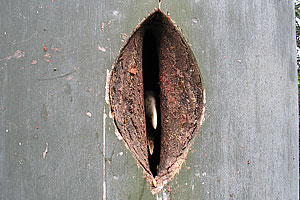 Ain't love grand? Once courtship and mating are over, the female hornbill finds a tree hollow and seals herself in with dung, fruit and pellets of mud.
Ain't love grand? Once courtship and mating are over, the female hornbill finds a tree hollow and seals herself in with dung, fruit and pellets of mud.
I love our hornbills. Situated in the Rainforest section of the Zoo, between our gibbons and our chimps, they are often overlooked, yet I find them fascinating.
The female has the bright blue gular pouch (an expandable throat sac, used for short-term storage of food) and the male has the pale yellow version. Like all hornbills, they have a distinctively large and down-turned beak. These Malayan Wreathed Hornbills are one of the 54 species found in Asia and Africa.
Their dramatic nesting ritual is what makes them so interesting. Once courtship and mating are over, the female finds a tree hollow and seals herself in with dung, fruit and pellets of mud. The male gathers the pellets from the forest floor and swallows them, later regurgitating small saliva-cased building materials. He then gives them to the female who stays inside the nest leaving a slit for a window big enough to receive food and materials. For the next 6-8 weeks the male feeds the female through this opening. She does not emerge until she has molted and re-grown fresh feathers and her young has grown and become feathered, as well. Then, both mother and child knock down the wall and appear on the scene, happy and healthy. Last year the public was enthralled, as our hornbills participated in this ritual.
The zoo is concerned with the status of hornbills in the wild, and since 2004, the Oakland Zoo Conservation Fund has worked with a fantastic program coordinated by the Hornbill Research Foundation. Besides collecting data, the foundation has launched a Hornbill Nest Adoption Program, which works to foster conservation of these beautiful birds. Illegal logging and the poaching of young birds for the pet trade are the key issues facing hornbills. The Nest Adoption Program employs local people to look after the hornbills in their nests and collect scientific data about them.
